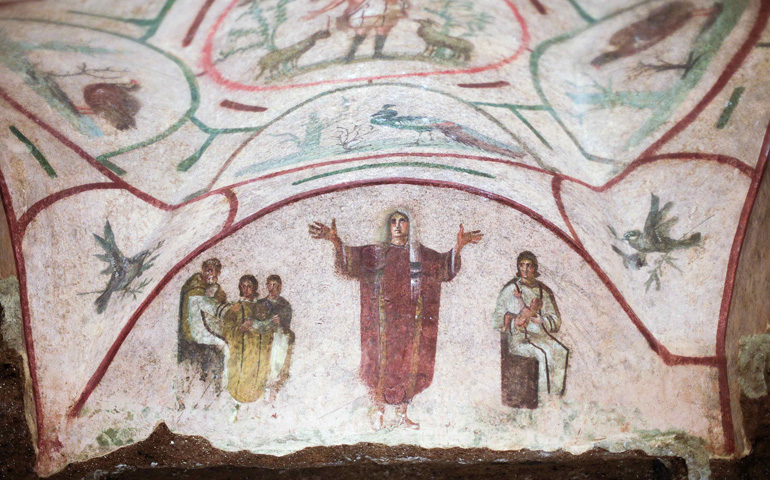
A fresco inside the Catacomb of Priscilla in Rome (CNS/Max Rossi)
Thanks to collaboration between Google Street View and the Vatican, Rome's catacombs are now accessible to anyone with an Internet connection. However, the move has created controversy for what some say the catacombs hold.
Google Street View on Tuesday unveiled a "see-inside" option to explore nearly the entire 8-mile complex of catacombs below Rome, including the art-filled Catacombs of Priscilla, according to Catholic News Service. Google has started to create virtual self-guided tours of famous locations, like the Eiffel Tower and the Great Barrier Reef, using special 360-degree cameras that people wear like a backpack.
"If you can find catacombs, if you can find frescos, if you can find museums online, then you will be willing to know more," Georgia Albetino of Google's Italian public policy team told Catholic News Agency on Tuesday.
A group of Catholics say people will certainly know more after taking the Google catacomb tour: They say the catacombs hold evidence of ancient women priests.
"We are delighted that the Vatican has restored these frescoes of women priests celebrating Eucharist in the Catacomb of St. Priscilla's in Rome," Bridget Mary Meehan, a bishop ordained through the Association of Roman Catholic Women Priests, wrote in a blog post Wednesday.
The frescoes in the Catacombs of Priscilla were recently restored, so the Google Street View images reveal paintings that look fresh and richly colored, even though they date back to the first few centuries. Moving virtually through the Catacombs of Priscilla's winding passageways, one can find not only the oldest known depiction of the Madonna and child, but also biblical scenes, including Jesus raising Lazarus from the dead and paintings of Saints Peter and Paul.
Now that anyone can tour the catacombs and see these frescoes via Google, members of the Association of Roman Catholic Women Priests say they have let the media know they have written about and believe that two frescoes in the Catacombs of Priscilla provide evidence of an ancient tradition of women deacons, priests and even bishops.
Not all accept that assertion.
"This is an elaboration that has no foundation in reality," Barbara Mazzei of the Pontifical Commission on Sacred Archaeology told Reuters.
Meehan wrote an article in 2008, "There Have Always Been Women Priests," for the Association of Roman Catholic Women Priests. In the article, Meehan describes ancient frescoes, including two in the Catacombs of Priscilla, portraying what she says are women in liturgical roles and vestments.
The first Catacombs of Priscilla fresco Meehan mentions "depicts a woman deacon in the center vested in a dalmatic, her arms raised in the orans position for public worship."
In the same painting, Meehan says there is also "a woman being ordained a priest by a bishop seated in a chair. She is vested in an alb, chasuble, and amice, and holding a gospel scroll."
The third woman in the painting "is wearing the same robe as the bishop on the left and is sitting in the same type of chair," Meehan wrote.
In her article, Meehan also quotes archeologist and theologian Dorothy Irvin, who said she found another fresco in the Catacombs of Priscilla of women "conducting a Eucharistic banquet."
"This is a fairy tale, a legend," Fabrizio Bisconti, superintendent of religious heritage archeological sites owned by the Vatican, told Reuters. He said any talk of women in liturgical roles was "sensationalist and absolutely not reliable."
The Associated Press, however, wrote Tuesday that one of the Priscilla frescoes "features a group of women celebrating a banquet, said to be the banquet of the Eucharist," and the other "features a woman, dressed in a dalmatic -- a cassock-like robe -- with her hands up in the position used by priests for public worship."
Sr. Chris Schenk, founder of FutureChurch, has led pilgrimages to the Priscilla catacombs many times. She told NCR the Catacombs of Priscilla, compared to other catacombs she has visited, are woman-centered, a place where ancient women went to pray and where females are depicted in many frescoes.
Of the three-woman fresco, Schenk said, "You really can't say that the one woman is being ordained into the priesthood because what the priesthood meant in the second or first century was not very clear."
"It does appear that the woman is being celebrated, consecrated, blessed for some kind of leadership role," Schenk said.
The fresco of the women at the banquet is labeled by the Catacombs of Priscilla guidebook as "a banquet of the Holy Eucharist," Schenk said, whereas Bisconti told AP it was "a funeral banquet."
Schenk said funeral banquets were raucous affairs, and people depicted in those paintings were falling off their couches in drunkenness.
Instead, the women at this banquet "are serious-looking people. There are no toasting messages above them. You can see clearly the goblet, as well as the fish and the seven bread baskets, referring to the story of the loaves and fishes, which historically is a eucharistic motif," Schenk said.
She also told NCR ancient women were chastised by the church for leading early eucharistic banquets, so a depiction of one isn't "a fairy tale" like Bisconti said.
"I think we shouldn't be so critical, even if people are making speculative interpretations," Schenk said. "Everyone has bias."
[Megan Fincher is a Bertelsen NCR intern. Her email address is mfincher@ncronline.org.]


